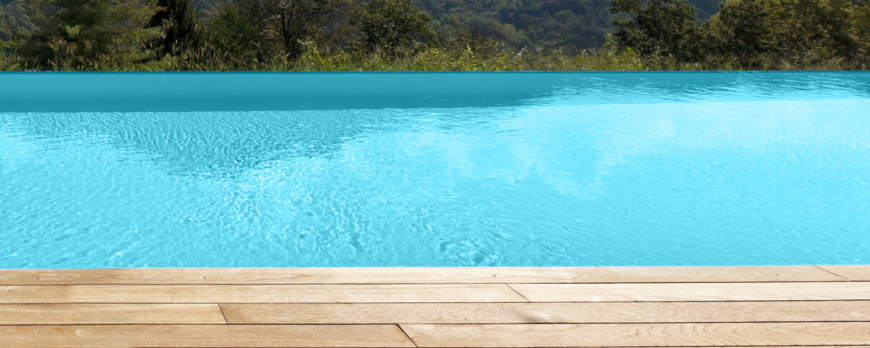

Our 4-step tips for clean, healthy water all year round.
The regular maintenance of your pool is based on 4 main steps that guarantee a good quality, clear and healthy water. Observe these steps and you can bathe in a clean and pleasant pool, without risk to your health.
1. WATER BALANCE
Water balance is the basis of water treatment. It is the first step to achieving a healthy pool water and the best possible swimming comfort. A correct adjustment of the pH between 7.2 and 7.4 is the essential basis for water maintenance. If the pH is outside the recommended area, it may cause skin and eye irritation and equipment degradation. Other treatment steps will also be less effective. pH instability can also be caused by low alkalinity (TAC less than 80 mg/L). A well-adjusted TAC prevents pH fluctuations and strengthens water balance. The pH must be monitored at least once a week.

2. WATER DISINFECTION
In addition to the balance of water, the disinfection is an essential step in the treatment of a pool in order to eliminate impurities (bacteria, microbes). Without addition of disinfectant, the water becomes very quickly cloudy and unsightly. The level of hygiene in the basin is insufficient and bathing is not recommended. Effective disinfection is therefore necessary to obtain a clean and crystalline water. The method of chlorine disinfection is best known. However, alternative methods such as active oxygen or bromine exist. Disinfection must be continuous throughout the bathing season. In case of problems (algae, turbidity, sticky deposits), a shock disinfection must be carried out. Keep the chlorine level between 1.5 and 2 mg/l.

3. CONTROL OF ALGAE
Simple disinfection is not always sufficient to prevent algae blooms in the pool. Prevention is necessary to slow their growth and prevent them from spreading into the basin. Algae can develop rapidly via spores carried by the winds, thus they permanently enter the water of the basin. Algae promotes the growth of bacteria and fungi. Slippery deposits of algae can cause accidents. Regularly add an algaecide to prevent algae blooms, especially when exposed to the sun’s rays and heat that promote their growth. It is easier and more economical to prevent the appearance of algae than to get rid of them once they are in the pond.

4. FLOCCULATION (FOR SAND/GLASS FILTER)
Flocculation ensures clear water for your pool. Cloudy water is a phenomenon that affects all pools one day. Particulates in the water are responsible. Most filters are unable to filter such fine particles. As a result, water becomes cloudy. Flocculation makes suspended particles filterable. The flocculant gives them enough size for the filter to hold them. A simple backwash allows them to be evacuated. The use of a flocculant is recommended only in the presence of a sand/glass filter. For swimming pools equipped with cartridge filters, we recommend the use of a clarifier.
Analysis cookies are used to carry out anonymous analysis of user behavior on the website and allow measuring user activity and creating Browse profiles to improve websites.
|
Name |
Owner |
Data collected |
Purpose |
Duration |
|
_ga |
First-party cookie |
Visitor sessions. |
Analytics. |
2 years. |
|
_gid |
First-party cookie |
Visitor sessions. |
Analytics. |
1 day. |
|
_ga_ML8VHE2LCY |
First-party cookie |
Visitor sessions. |
Analytics. |
1 day. |
|
_gat_gtag_UA_[ID] |
First-party cookie |
Visitor sessions. |
Analytics. |
1 minute. |
Advertising cookies allow for the management of the website's advertising spaces. Furthermore, these cookies can be for personalized advertising, thus enabling the management of the website's advertising spaces based on the user's behavior and Browse habits. This is how their profile is obtained, allowing for the personalization of the advertising shown in the user's browser or on the user's other profiles and social networks.
|
Name |
Holder |
Data Collected |
Purpose |
Duration |
|
IDE |
Third-party cookie (doubleclick.net) |
Preferences, links, conversions, and interactions with advertisements. |
Advertising |
1 year. |
|
_fbp |
|
It is used to store and track website visits. | Advertising |
3 months |
Technical cookies are those that facilitate the user's navigation and the use of the different options or services offered by the web, such as identifying the session, allowing access to certain areas, facilitating orders, purchases, filling in forms, registrations, security, facilitating functionalities. (videos, social networks ...).
Personalized cookies allow the user to access the services according to their preferences (language, browser, configuration…).
|
Name |
Owner |
Collected Data |
Purpose |
Duration |
|
validacio_cookies |
Own cookie |
Management of cookies acceptance. |
Technique. |
1 year. |
|
(Aleatorio) |
Own cookie |
Visitor session management.. |
Technique. |
At the end of the session in the browser. |